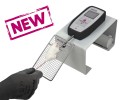Authors
D.P. Roberson, A.M. Binshtok, F. Blasl, B.P. Bean, C.J. Woolf.
Lab
Children's Hospital, FM Kirby Neurobiology Center and Department of Neurology, Boston, USA.
Journal
British Journal of Pharmacology
Abstract
BACKGROUND AND PURPOSE: We have developed a strategy to target the permanently charged lidocaine derivative lidocaine N-ethyl bromide (QX-314) selectively into nociceptive sensory neurons through the large-pore transient receptor potential cation channel subfamily V (TRPV1) noxious heat detector channel. This involves co-administration of QX-314 and a TRPV1 agonist to produce a long-lasting local analgesia. For potential clinical use we propose using lidocaine as the TRPV1 agonist, because it activates TRPV1 at clinical doses. EXPERIMENTAL APPROACH: We conducted experiments in rats to determine optimal concentrations and ratios of lidocaine and QX-314 that produce the greatest degree and duration of pain-selective block when administered nearby the sciatic nerve: reduction in the response to noxious mechanical (pinch) and to radiant heat stimuli, with minimal disruption in motor function (grip strength). KEY RESULTS: A combination of 0.5% QX-314 and 2% lidocaine produced 1 h of non-selective sensory and motor block followed by >9 h of pain-selective block, where grip strength was unimpaired. QX-314 at this concentration had no effect by itself, while 2% lidocaine by itself produced 1 h of non-selective block. The combination of 0.5% QX-314 and 2% lidocaine was the best of the many tested, in terms of the duration and selectivity of local analgesia. CONCLUSIONS AND IMPLICATIONS: Targeting charged sodium channel blockers into specific sets of axons via activation of differentially expressed large-pore channels provides an opportunity to produce prolonged local analgesia, and represents an example of how exploiting ion channels as a drug delivery port can be used to increase the specificity and efficacy of therapeutics.
BIOSEB Instruments Used:
Grip strength test (BIO-GS3)

 Pain - Thermal Allodynia / Hyperalgesia
Pain - Thermal Allodynia / Hyperalgesia Pain - Spontaneous Pain - Postural Deficit
Pain - Spontaneous Pain - Postural Deficit Pain - Mechanical Allodynia / Hyperalgesia
Pain - Mechanical Allodynia / Hyperalgesia Learning/Memory - Attention - Addiction
Learning/Memory - Attention - Addiction Physiology & Respiratory Research
Physiology & Respiratory Research
 Pain
Pain Metabolism
Metabolism Motor control
Motor control Neurodegeneration
Neurodegeneration Cross-disciplinary subjects
Cross-disciplinary subjects Muscular system
Muscular system General activity
General activity Mood Disorders
Mood Disorders Other disorders
Other disorders Joints
Joints Central Nervous System (CNS)
Central Nervous System (CNS) Sensory system
Sensory system
